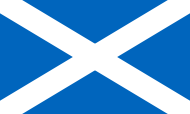Royal Standard of Scotland
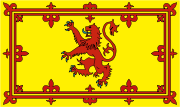 |
|
| Name | Royal Standard of Scotland |
|---|---|
| Proportion | 5:4 |
| Adopted | Circa 1222 |
| Design | Red (Gules) lion rampant within a double border, having a motif of alternating heraldic lilies, on a yellow (Or) field. |
The Royal Standard of Scotland, also known as the Banner of the King of Scots,[1] or more commonly the Lion Rampant of Scotland,[2] is the Scottish Royal Banner of Arms.[3] Used historically by the King of Scots, the Royal Standard of Scotland differs from Scotland's national flag, the Saltire, in that its correct use is restricted by an Act of the Parliament of Scotland to only a few Great Officers of State who officially represent the Sovereign in Scotland.[3] It is also used in an official capacity at royal residences in Scotland when the Sovereign is not present.[4]
The earliest recorded use of the Lion rampant as a royal emblem in Scotland is by Alexander II in 1222;[5] with the additional embellishment of a double border set with lilies occurring during the reign of Alexander III (1249–1286).[5] This emblem occupied the shield of the royal coat of arms of the ancient Kingdom of Scotland which, together with a royal banner displaying the same, was used by the King of Scots until the Union of the Crowns in 1603, when James VI acceded to the thrones of the Kingdom of England and Kingdom of Ireland.[6] Since 1603, the Lion rampant of Scotland has been incorporated into both the royal arms and royal banners of successive Scottish then British monarchs in order to symbolise Scotland; as can be seen today in the Royal Standard of the United Kingdom.[7] Although now officially restricted to use by representatives of the Sovereign and at royal residences, the Royal Standard of Scotland continues to be one of Scotland's most recognisable symbols.[8]
Contents |
Design
Displaying a red lion rampant, with blue tongue and claws, within a red double border on a yellow background, the design of the Royal Standard of Scotland is formally specified in heraldry as: Or, a lion rampant Gules armed and langued Azure within a double tressure flory counter-flory of the second,[9] meaning: A gold (Or) background, whose principal symbol is a red (Gules) upright lion (lion rampant) with blue (Azure) claws and tongue (armed and langued), surrounded by a two lined border (tressure) decorated with opposing pairs of floral symbols (flory counter-flory) of the second colour specified in the blazon (Gules). Used as a house flag, its proportions are 5:4,[10] however flag manufacturers themselves may also adopt alternative ratios, including 1:2 or 2:3.[11]
History
The Lion rampant may have been adopted in the 12th century by William I "the Lion" (1165–1214), however there is no evidence of its use as "the Arms of the Dominion of Scotland" before 1222, when it appeared upon the Great Seal of his son, Alexander II (1214–1249).[5] However, its use in Scotland may have its origins during the reign of Malcolm III (1058–1093), given that the central Lion rampant motif is also used as a badge by those Irish clans who, in common with Malcolm III, are linked to the legendary Milesian genealogies.[12][13] An earlier recorded Scottish royal standard featured a dragon, which was used at the Battle of the Standard in 1138 by David I (1124–1153).[14]
Following the Union of the Crowns of England, Ireland and Scotland in 1603, the Royal Standard of Scotland was incorporated into the royal standards of successive Scottish then, following the Acts of Union in 1707, British monarchs; with all such royal standards being quartered to include the banner of the arms of each individual realm. Since 1603, the Royal Standard of Scotland has appeared in both the first and fourth quarters of the quartered royal standard used in Scotland, while appearing only in the second quarter of that version used elsewhere.[4]
Protocol
Use at royal residences
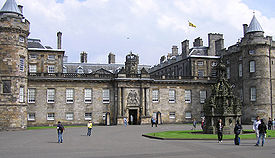
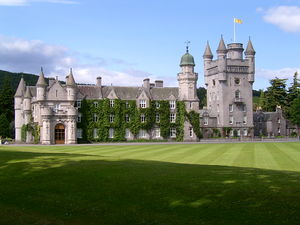
The Royal Standard of Scotland is used officially at the Scottish royal residences of the Palace of Holyroodhouse, Edinburgh, and Balmoral Castle, Aberdeenshire, when Her Majesty The Queen is not in residence. The Royal Standard of the United Kingdom used in Scotland is flown when the Sovereign is present.[4]
Use by representatives of the Sovereign
In the tradition of Scottish heraldry, use of the Royal Standard of Scotland is not restricted to the Sovereign.[15] Several Great Officers of State who officially represent the Sovereign in Scotland are permitted to use the Royal Standard of Scotland, including; the First Minister of Scotland (as Keeper of the Great Seal of Scotland), Lord Lieutenants within their respective Lieutenancies, the Lord High Commissioner to the General Assembly of the Church of Scotland, the Lord Lyon King of Arms and other lieutenants who may be specially appointed by the Sovereign.[3]
Use by the Heir Apparent
A variation of the Royal Standard of Scotland is used by the heir apparent to the King of Scots, the Duke of Rothesay, whose standard is the Royal Standard of Scotland defaced with an Azure coloured plain label of three points.[16] The personal banner of the current Duke, His Royal Highness, The Prince Charles, also features the same, displayed upon an inner shield.[17]
Legal status
As the personal banner of the Sovereign, use of the Royal Standard of Scotland is restricted under the Act of the Parliament of Scotland 1672 cap. 47 and 30 & 31 Vict. cap. 17, and any unauthorised use of such is an offence under the Act.[3] In 1978 a St Albans linen merchant, Denis Pamphilon, was fined £100 daily for usurpation of the standard on decorative bedspreads until he desisted, and both Rangers F.C. and the Scottish National Party have been admonished by the Court of the Lord Lyon for their improper and non-authorised use of the standard.[18] Despite such action, the flag continues to feature on a variety of merchandise and souvenirs produced commercially for Scotland's economically important tourism industry.[19][20]
In 1934, George V issued a Royal Warrant authorising use of the Royal Standard of Scotland during the Silver Jubilee celebrations, due to take place the following year. However, such use was restricted to hand-held flags for "decorative ebullition" as a mark of loyalty to the Sovereign; the standard was not to be flown from flagpoles or public buildings.[21] The use of hand-held flags at state occasions, such as the opening of the Scottish Parliament,[22] and at sporting events,[23] continues to be authorised by this Royal Warrant, although according to former Lord Lyon Robin Blair, in an interview given to the Sunday Post in November 2007, such use at sporting events "was not envisaged in 1935".[24]
Appearance in other Royal Standards
As well as forming the basis of the standard of the Duke of Rothesay,[25] the Royal Standard of Scotland has since 1603 been a component of what is now styled the Royal Standard of the United Kingdom; both that version used exclusively in Scotland and that used elsewhere. It similarly appears in the Royal Standard of Canada,[26] with the arms of Canada reflecting the royal symbols of England, Scotland, Ireland and France.[27]
 The Standard of the Duke of Rothesay, viz the Royal Standard of Scotland defaced with a plain label of three points Azure. |
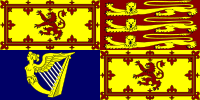 The Royal Standard of the United Kingdom used in Scotland, featuring the Royal Standard of Scotland in the first and fourth quarters. |
 The Royal Standard of the United Kingdom used outwith Scotland, featuring the Royal Standard of Scotland in the second quarter. |
 The Royal Standard of Canada, featuring the Royal Standard of Scotland in the second quarter of the first two divisions. |
National Flag of Scotland
The Flag of Scotland, also known as the Saint Andrew's Cross or more commonly The Saltire, is the national flag of Scotland.[28] The Saltire is the correct flag for all individuals and corporate bodies to fly in order to demonstrate both their loyalty and Scottish nationality.[29] It is also, where possible, flown from Scottish Government buildings every day from 8am until sunset, with certain exceptions; for example United Kingdom National Days.[30]
See also
- Royal coat of arms of Scotland
- Royal coat of arms of the United Kingdom
- Royal Standard of the United Kingdom
- Arms of Canada
- Royal Standard of Canada
- List of Scottish flags
- List of British flags
- Scottish heraldry
- Duke of Rothesay
- List of Scottish monarchs
References
- ↑ Innes of Learney, Sir Thomas (1934). Scots heraldry: a practical handbook on the historical principles and modern application of the art and science. Oliver and Boyd. pp. 186. Google Books
- ↑ Tytler, Patrick F (1845). History of Scotland Volume 2, 1149-1603. William Tait. pp. 433. Google Books
- ↑ 3.0 3.1 3.2 3.3 "The "Lion Rampant" Flag". The Court of the Lord Lyon. http://www.lyon-court.com/lordlyon/237.html. Retrieved 2008-10-10.
- ↑ 4.0 4.1 4.2 "Union Jack". The Royal Household. http://www.royal.gov.uk/MonarchUK/Symbols/UnionJack.aspx. Retrieved 2009-08-28.
- ↑ 5.0 5.1 5.2 McAndrew, Bruce (2006). Scotland's Historic Heraldry. Boydell Press. p. 24. ISBN 1843832615. "Most important, the convex shield now displays arms of A lion rampant, without as yet the embellishment of a border of any sort" At Google Book Search
- ↑ "United Kingdom Monarchs (1603-present)". The Royal Household. http://www.royal.gov.uk/HistoryoftheMonarchy/KingsandQueensoftheUnitedKingdom/KingsandQueensoftheUnitedKingdom.aspx. Retrieved 2009-12-15.
- ↑ "Royal Standard". The Royal Household. http://www.royal.gov.uk/MonarchUK/Symbols/RoyalStandard.aspx. Retrieved 2009-12-15.
- ↑ "'Super regiment' badge under fire". BBC News (British Broadcasting Corporation). 2005-08-16. http://news.bbc.co.uk/2/hi/uk_news/scotland/4157274.stm. Retrieved 2009-12-09.
- ↑ Cogné, Daniel; Boudreau, Claire; Vachon, Auguste (1998), "Genealogica & heraldica: proceedings of the 22nd International Congress of Genealogical and Heraldic Sciences in Ottawa", Ottawa, Canada: University of Ottawa Press, pp. 512, http://books.google.co.uk/books?id=8SjtPuppLtYC&dq=Daniel+Cogn%C3%A9,+Claire+Boudreau,+Auguste+Vachon&printsec=frontcover&source=bl&ots=UBxVNoU70w&sig=aNWmz8IRFYT3PZL0Exi-ZJvDeAc&hl=en&ei=GC4oS5XEFdX24Abt-JG6DQ&sa=X&oi=book_result&ct=result&resnum=1&ved=0CAgQ6AEwAA#v=onepage&q=rampant&f=false, retrieved 2009-12-15
- ↑ "Further Guidance on Flags". The Court of the Lord Lyon. http://www.lyon-court.com/lordlyon/375.html. Retrieved 2009-09-10.
- ↑ "Scottish Standard". UK Flags. Flying Colours Flagmakers. http://www.flyingcolours.org/html/scottish%20standard.htm. Retrieved 2009-12-11.
- ↑ O'Hart, John (1989). Irish pedigrees: or, The origin and stem of the Irish nation. Genealogical Publishing Com. p. 55. ISBN 0806307374. "Milesius of Spain bore three Lions in his shield and standard, for the following reasons; namely, that, in his travels in his younger days into foreign countries, passing through Africa, he, by his cunning and valour, killed in one morning three Lions; and that, in memory of so noble and valiant an exploit, he always after bore three Lions on his shield, which his two surviving sons Heber and Heremon, and his grandson Heber Donn, son of Ir, after their conquest of Ireland, divided amongst them, as well as they did the country: each of them bearing a Lion in his shield and banner, but of different colours; which the Chiefs of their posterity continue to this day: some with additions and differences; others plain and entire as they had it from their ancestors." Google Books
- ↑ Pepper, George (1829). The Irish Shield and Monthly Milesian. Volume 937 of American periodical series, 1800-1850. s.n.. p. 309. "From the royal Irish source sprung the Malcolms, the Bruces, the Baliols, the Stuarts, the Campbells as well as the Douglases, and Macullamore, and the reigning family of England, as the Irish and Scottish genealogies will prove." Google Books
- ↑ Strong, John; Tatlock, Perry (1950). The legendary history of Britain: Geoffrey of Monmouth's Historia Regum Britanniae and its early vernacular versions. University of California Press. p. 329.
- ↑ Bartram, Graham (2005). British flags & emblems. Flag Institute. p. 30. ISBN 9781862322974. "The usage of the Lion Rampant banner follows Scottish practice in that it is not restricted to the monarch but is used by the monarch's high-ranking representatives. These are the Lord High Commissioner to the General Assembly of the Church of Scotland, the Lord Lyon King of Arms, the Keeper of the Great Seal (who is the Scottish First Minister) and the Lord Lieutenants of the Counties." At Google Book Search
- ↑ McAndrew, Bruce A. (2006). Scotland's historic heraldry. Boydell Press. p. 276. ISBN 1843832615.
- ↑ "Standards". Website of The Prince of Wales. http://www.princeofwales.gov.uk/personalprofiles/theprinceofwales/abouttheprince/standards/. Retrieved 2009-08-28.
- ↑ Groom, Nick (2006). The Union Jack: the Story of the British Flag. Atlantic Books. p. 294. ISBN 1843543362.
- ↑ "The Scottish Souvenir Shop". World Souvenirs Ltd. http://www.thescottishsouvenirshop.com/cgi-bin/ss000001.pl?SS=Lion+rampant&ACTION=Go!&PR=-1&TB=A&SHOP=. Retrieved 2009-12-15.
- ↑ "ScotWeb". Scotweb Marketing Ltd. http://www.scotweb.co.uk/multisearch?set_ps_offset=0:multi_search=Lion%20Rampant. Retrieved 2009-12-12.
- ↑ Eriksen, Thomas H; Jenkins, Richard (2007). Flag, nation and symbolism in Europe and America. Routledge. p. 81. ISBN 0415444047. "King George V issued a Royal Warrant in 1934 that allowed the standard to be used during the Silver Jubilee celebrations of 1935 in Scotland 'as a mark of respect to the Sovereign', but not to be flown on flagpoles or public buildings - it was solely for 'decorative ebullition', comparable today with its being displayed at football matches." Google Books
- ↑ "Holyrood Opening". The Scottish Parliament. http://www.scottish.parliament.uk/nmCentre/images/openingCeremony/PreviewPages/PreviewPage65.htm. Retrieved 2009-12-16.
- ↑ Gordon, Phil (2003-03-29). "How Scottish fans fell out of love with Hampden and their team". The Times (Times Newspapers Ltd). http://www.timesonline.co.uk/tol/sport/football/scotland/article1124389.ece. Retrieved 2009-12-15.
- ↑ "The Lion Rampant & Heraldry". The McGeachie Surname Forum. http://www.djmcgeachie.co.uk/forum/viewtopic.php?t=60&sid=8a73745574828ff4e1edcebf28785078. Retrieved 2009-08-28.
- ↑ McAndrew, Bruce (2006). Scotland's Historic Heraldry. Boydell Press. p. 276. ISBN 1843832615. "From ca 1398, the King's eldest son was formally the Duke of Rothesay, though he is seldom found thus stated. Moreover, in 1469 the earldom of Carrick, lordship of Bute and the castle of Rothesay were permanently united and considered as the fief of the eldest son of the King of Scots; the dukedom of Rothesay is deemed to descend with them. His arms were the royal arms of Scotland with the addition of a label of three points azure" At Google Books
- ↑ "Personal flags and standards". Canadian Heritage. http://www.pch.gc.ca/pgm/ceem-cced/symbl/o7-eng.cfm. Retrieved 2009-12-15.
- ↑ "Ceremonial and Canadian Symbols". Canadian Heritage. http://www.pch.gc.ca/pgm/ceem-cced/symbl/arm2-eng.cfm. Retrieved 2009-08-28.
- ↑ Gardiner, James. "Scotland's National Flag, the Saltire or St Andrews Cross". Scran. Royal Commission on the Ancient and Historical Monuments of Scotland. http://www.scran.ac.uk/database/record.php?usi=000-000-113-368-C. Retrieved 2009-12-09.
- ↑ "The Saltire". The Court of the Lord Lyon. http://www.lyon-court.com/lordlyon/236.html. Retrieved 2009-12-09.
- ↑ "Flag Flying Guidance". Issue No. 13 (Valid from January 2009). The Government of Scotland. 2009-01-01. http://www.scotland.gov.uk/Topics/People/royal-ceremonial/flag-guidance. Retrieved 2009-12-09.
External links
| Standard of the Duke of Rothesay, together with the Royal Standard of the United Kingdom used in Scotland, hanging in the Chapel of the Order of the Thistle, St. Giles' Cathedral, Edinburgh. 2008-07-21. By Beery. Accessed 2009-12-16 | |
- The Court of the Lord Lyon website
- The Scottish Government - Flag Flying Guidance website
- The British Monarchy - Official website
|
|||||||||||||||||
|
||||||||||||||||||||||||||||||||
